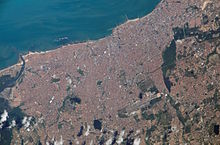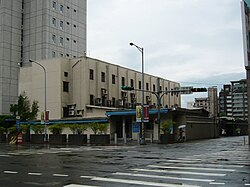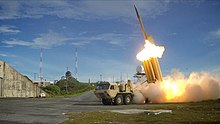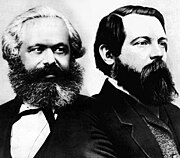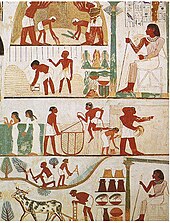From Wikipedia, the free encyclopedia
Marxist historiography, or historical materialist historiography, is an influential school of historiography. The chief tenets of Marxist historiography include the centrality of social class, social relations of production in class-divided societies that struggle against each other, and economic constraints in determining historical outcomes (historical materialism). Marxist historians follow the tenets of the development of class-divided societies, especially modern capitalist ones.
Yet, the way Marxist historiography has developed in different
regional and political contexts has varied. Marxist historiography has
had unique trajectories of development in the West, in the Soviet Union, and in India, as well as in the pan-Africanist and African-American traditions, adapting to these specific regional and political conditions in different ways.
Marxist historiography has made contributions to the history of the working class, and the methodology of a history from below.
Marxist historiography is sometimes criticized as deterministic, in that it posits a direction of history, towards an end state of history as classless
human society. Marxist historiography within Marxist circles is
generally seen as a tool; its aim is to bring those it perceives as
oppressed by history to self-consciousness,
and to arm them with tactics and strategies from history. For these
Marxists, it is both a historical and a liberatory project.
However, not all Marxist historiography is socialist. Methods
from Marxist historiography, such as class analysis, can be divorced
from the original political intents of Marxism and its deterministic
nature; historians who use Marxist methodology, but disagree with the
politics of Marxism, often describe themselves as "marxian" historians,
practitioners of this "marxian historiography" often refer to their
techniques as "marxian".
Marx and Engels
Friedrich Engels' (1820–1895) most important historical contribution to the development of Marxist historiography was Der Deutsche Bauernkrieg (The German Peasants' War, 1850), which analysed social warfare in early Protestant Germany in terms of emerging capitalist classes. Although The German Peasants' War was overdetermined lacked a rigorous engagement with archival sources, it exemplifies an early Marxists' interest in history from below and in class analysis, it also attempts a dialectical analysis.
Karl Marx's (1818–1883) most important works on social and political history include The Eighteenth Brumaire of Louis Napoleon (1852), The Communist Manifesto (1848), The German Ideology (written in 1845, published in 1932), and those chapters of Das Kapital (1867-1894) dealing with the historical emergence of capitalists and proletarians from pre-industrial English society.
Engels' short treatise The Condition of the Working Class in England (German: Die Lage der arbeitenden Klasse in England, 1845; English-language translation published in 1887) was salient in giving a socialist impetus to British politics from then on, for e.g. the Fabian Society.
Labour and class struggle
The
key to understanding Marxist historiography is his view of labour. For
Marx "historical reality is none other than objectified labor, and all
conditions of labor given by nature, including the organic bodies of
people, are merely preconditions and 'disappearing moments' of the labor
process."
This emphasis on the physical as the determining factor in history
represents a break from virtually all previous historians. Until Marx
developed his theory of historical materialism,
the overarching determining factor in the direction of history was some
sort of divine agency. In Marx's view of history "God became a mere
projection of human imagination" and more importantly "a tool of
oppression".
There was no more sense of divine direction to be seen. History moved
by the sheer force of human labour, and all theories of divine nature
were a concoction of the ruling powers to keep the working people in
check. For Marx, "The first historical act is... the production of
material life itself."
As one might expect, Marxist history not only begins with labour, it
ends in production: "history does not end by being resolved into
"self-consciousness" as "spirit of the spirit," but that in it at each
stage there is found a material result: a sum of productive forces, a
historically created relation of individuals to nature and to one
another, which is handed down to each generation from its
predecessor..." For further, and much more comprehensive, information on this topic, see historical materialism.
Historic materialism
Introduction
Historical materialism is a methodology to understand human societies
and their development throughout history. Marx's theory of history
locates historical change in the rise of class societies and the way
humans labour together to make their livelihoods. Marx argues that the
introduction of new technologies
and new ways of doing things to improve production eventually lead to
new social classes which in turn result in political crises which can
threaten the established order.
Marx's view of history is in contrast to the commonplace notion
that the rise and fall of kingdoms, empires and states, can broadly be
explained by the actions, ambitions and policies of the people at the
top of society kings, queens, emperors, generals, or religious leaders.
This view of history is summed up by the 19th-century Scottish
philosopher Thomas Carlyle
who wrote "the history of the world is nothing but the biography of
great men". An alternative to the "great man" theory is that history is
shaped by the motivating force of "great ideas" – the struggle of reason
over superstition or the fight for democracy and freedom.
The "great man"
and occasionally "great women" theory of history and the view that
history is primarily shaped by ideas has provoked no end of debate but
many historians have believed there are more fundamental patterns at
play beneath historical events.
Karl Marx (1818–1883) asserted that the material conditions of a society's mode of production, or in Marxist terms a society's productive forces and relations of production,
fundamentally determine society's organization and development
including the political commitments, cultural ideas and values that
dominate in any society.
Marx argues that there is a fundamental conflict between the
class of people who create the wealth of society and those who have
ownership or control of the means of production, decide how society's
wealth and resources are to be used and have a monopoly of political and
military power. Historical materialism provides a profound challenge to
the view that the historical process has come to a close and that
capitalism is the end of history. Since Marx's time, the theory has been modified and expanded. It now has many Marxist and non-Marxist variants.
The main modes of production that Marx identified generally include primitive communism, slave society, feudalism, mercantilism, and capitalism.
In each of these social stages, people interacted with nature and
production in different ways. Any surplus from that production was
distributed differently as well. To Marx, ancient societies (e.g. Rome
and Greece) were based on a ruling class of citizens and a class of
slaves; feudalism was based on nobles and serfs; and capitalism based on the capitalist class (bourgeoisie) and the working class (proletariat).
Description
The discovery of the materialist conception of history, or rather,
the consistent continuation and extension of materialism into the domain
of social phenomenon, removed two chief defects of earlier historical
theories. In the first place, they at best examined only the ideological
motives of the historical activity of human beings, without grasping
the objective laws governing the development of the system of social
relations. ... in the second place, the earlier theories did not cover
the activities of the masses of the population, whereas
historical materialism made it possible for the first time to study with
scientific accuracy the social conditions of the life of the masses and
the changes in these conditions.
— Russian Marxist theoretician and revolutionary Vladimir Lenin, 1913
Society does not consist of
individuals, but expresses the sum of interrelations, the relations
within which these individuals stand.
In the Marxian view, human history is like a river. From any given
vantage point, a river looks much the same day after day. But actually
it is constantly flowing and changing, crumbling its banks, widening and
deepening its channel. The water seen one day is never the same as that
seen the next. Some of it is constantly being evaporated and drawn up,
to return as rain. From year to year these changes may be scarcely
perceptible. But one day, when the banks are thoroughly weakened and the
rains long and heavy, the river floods, bursts its banks, and may take a
new course. This represents the dialectical part of Marx's famous
theory of dialectical (or historical) materialism.
— Hubert Kay, Life, 1948
Historical materialism builds upon the idea of historical progress that became popular in philosophy during the Enlightenment, which asserted that the development of human society has progressed through a series of stages, from hunting and gathering, through pastoralism and cultivation, to commercial society. Historical materialism rests on a foundation of dialectical materialism,
in which matter is considered primary and ideas, thought, and
consciousness are secondary, i.e. consciousness and human ideas about
the universe result from material conditions rather than vice versa. Marxism uses this materialist
methodology, referred to by Marx and Engels as the materialist
conception of history and later better known as historical materialism,
to analyse the underlying causes of societal development and change from
the perspective of the collective ways in which humans make their
living.
Historical materialism springs from a fundamental underlying
reality of human existence: that in order for subsequent generations of
human beings to survive, it is necessary for them to produce and
reproduce the material requirements of everyday life.
Marx then extended this premise by asserting the importance of the fact
that, in order to carry out production and exchange, people have to
enter into very definite social relations, or more specifically,
"relations of production". However, production does not get carried out
in the abstract, or by entering into arbitrary or random relations
chosen at will, but instead are determined by the development of the
existing forces of production. How production is accomplished depends on the character of society's productive forces,
which refers to the means of production such as the tools, instruments,
technology, land, raw materials, and human knowledge and abilities in
terms of using these means of production.
The relations of production are determined by the level and character
of these productive forces present at any given time in history. In all
societies, Human beings collectively work on nature but, especially in class societies, do not do the same work. In such societies, there is a division of labour
in which people not only carry out different kinds of labour but occupy
different social positions on the basis of those differences. The most
important such division is that between manual and intellectual labour
whereby one class produces a given society's wealth while another is
able to monopolize control of the means of production and so both governs that society and lives off of the wealth generated by the labouring classes.
Marx's account of the theory is in The German Ideology (1845) and in the preface A Contribution to the Critique of Political Economy (1859). All constituent features of a society (social classes, political pyramid and ideologies) are assumed to stem from economic activity, forming what is considered as the base and superstructure.
The base and superstructure metaphor describes the totality of social
relations by which humans produce and re-produce their social existence.
According to Marx, the "sum total of the forces of production
accessible to men determines the condition of society" and forms a
society's economic base.
The base includes the material forces of production such as the labour, means of production and relations of production,
i.e. the social and political arrangements that regulate production and
distribution. From this base rises a superstructure of legal and
political "forms of social consciousness" that derive from the economic base that conditions both the superstructure and the dominant ideology of a society. Conflicts between the development of material productive forces and the relations of production provokes social revolutions, whereby changes to the economic base leads to the social transformation of the superstructure.
This relationship is reflexive, in that the base initially gives rise to the superstructure and remains the foundation of a form of social organization.
Those newly formed social organizations can then act again upon both
parts of the base and superstructure so that rather than being static,
the relationship is dialectic,
expressed and driven by conflicts and contradictions. Engels clarified:
"The history of all hitherto existing society is the history of class
struggles. Freeman and slave, patrician and plebeian, lord and serf, guild-master and journeyman, in a word, oppressor and oppressed,
stood in constant opposition to one another, carried on uninterrupted,
now hidden, now open fight, a fight that each time ended, either in a
revolutionary reconstitution of society at large, or in the common ruin
of the contending classes."
Marx considered recurring class conflicts as the driving force of
human history as such conflicts have manifested themselves as distinct transitional stages of development in Western Europe. Accordingly, Marx designated human history as encompassing four stages of development in relations of production:
- Primitive communism: co-operative tribal societies.
- Slave society: development of tribal to city-state in which aristocracy is born.
- Feudalism: aristocrats are the ruling class while merchants evolve into the bourgeoisie.
- Capitalism: capitalists are the ruling class, who create and employ the proletariat.
While historical materialism has been referred to as a materialist
theory of history, Marx did not claim to have produced a master-key to
history and that the materialist conception of history is not "an
historico-philosophic theory of the marche générale,
imposed by fate upon every people, whatever the historic circumstances
in which it finds itself." In a letter to editor of the Russian
newspaper paper Otetchestvennye Zapiskym (1877), he explained that his ideas are based upon a concrete study of the actual conditions in Europe.
Summary
To summarize, history develops in accordance with the following observations:
- Social progress is driven by progress in the material, productive forces a society has at its disposal (technology, labour, capital goods and so on)
- Humans are inevitably involved in productive relations (roughly
speaking, economic relationships or institutions), which constitute our
most decisive social relations. These relations progress with the development of the productive forces. They are largely determined by the division of labour, which in turn tends to determine social class.
- Relations of production
are both determined by the means and forces of production and set the
conditions of their development. For example, capitalism tends to
increase the rate at which the forces develop and stresses the accumulation of capital.
- The relations of production define the mode of production, e.g. the
capitalist mode of production is characterized by the polarization of
society into capitalists and workers.
- The superstructure—the
cultural and institutional features of a society, its ideological
materials—is ultimately an expression of the mode of production on which
the society is founded.
- Every type of state is a powerful institution
of the ruling class; the state is an instrument which one class uses to
secure its rule and enforce its preferred relations of production and
its exploitation onto society.
- State power is usually only transferred from one class to another by social and political upheaval.
- When a given relation of production no longer supports further
progress in the productive forces, either further progress is strangled,
or 'revolution' must occur.
- The actual historical process is not predetermined but depends on
class struggle, especially the elevation of class consciousness and
organization of the working class.
"Western" historiography
Karl Marx and Friedrich Engels worked in relative isolation together
outside the larger mainstream. However, by the turn of the twentieth
century, Marxist thought was perhaps the most prominent opposition to
the idealist traditions.
R. H. Tawney (1880–1962) was an early historian working in this tradition. The Agrarian Problem in the Sixteenth Century (1912) and Religion and the Rise of Capitalism
(1926), reflected his ethical concerns and preoccupations in economic
history. He was profoundly interested in the issue of the enclosure of
land in the English countryside in the sixteenth and seventeenth
centuries and Max Weber's thesis on the connection between the appearance of Protestantism
and the rise of capitalism. His belief in the rise of the gentry in the
century before the outbreak of the Civil War in England provoked the
"Storm over the Gentry" in which his methods were subjected to severe
criticisms by Hugh Trevor-Roper and John Cooper.
A circle of historians inside the Communist Party of Great Britain
(CPGB) was formed in 1946. It became a highly influential cluster of
British Marxist historians, who shared a common interest in and
contributed to history from below and class structure in early capitalist society. While some members of the group (most notably Christopher Hill [1912–2003] and E. P. Thompson [1924–1993]) left the CPGB after the 1956 Hungarian Revolution,
the common points of British Marxist historiography continued in their
works. They placed a great emphasis on the subjective determination of
history. E. P. Thompson famously engaged Althusser in The Poverty of Theory, arguing that Althusser's theory overdetermined history, and left no space for historical revolt by the oppressed.
Christopher Hill's studies on 17th-century English history were
widely acknowledged and recognized as representative of Marxist
historians and Marxist historiography in general. His books include Puritanism and Revolution (1958), Intellectual Origins of the English Revolution (1965 and revised in 1996), The Century of Revolution (1961), AntiChrist in 17th-century England (1971), The World Turned Upside Down (1972) and many others.
E. P. Thompson pioneered the study of history from below in his work, The Making of the English Working Class,
published in 1963. It focused on the forgotten history of the first
working-class political left in the world in the late-18th and
early-19th centuries. In his preface to this book, Thompson set out his
approach to writing history from below:
I am seeking to rescue the poor stockinger, the Luddite cropper, the "obsolete" hand-loom weaver, the "Utopian" artisan, and even the deluded follower of Joanna Southcott,
from the enormous condescension of posterity. Their crafts and
traditions may have been dying. Their hostility to the new industrialism
may have been backward-looking. Their communitarian ideals may have
been fantasies. Their insurrectionary conspiracies may have been
foolhardy. But they lived through these times of acute social
disturbance, and we did not. Their aspirations were valid in terms of
their own experience; and, if they were casualties of history, they
remain, condemned in their own lives, as casualties.
Thompson's work was also significant because of the way he defined
"class". He argued that class was not a structure, but a relationship
that changed over time. Thompson's work is commonly considered the most
influential work of history in the twentieth century and a crucial
catalyst for social history and from social history to gender history
and other studies of marginalized peoples.
His essay, "Time, Work, Discipline, and Industrial Capitalism" is also
hugely influential and argues that industrial capitalism fundamentally
altered (and accelerated) humans' relationship to time. He opened the
gates for a generation of labour historians, such as David Montgomery (1927–2011) and Herbert Gutman (1928–1985), who made similar studies of the American working classes.
Perhaps the most famous of the Communist historians was E. B.
Hobsbawm (1917–2012), who might be the most famous and widely read
historian of the 20th century. Hobsbawm is credited for establishing
many of the basic historical arguments of current historiography and
synthesizing huge amounts of modern historical data across time and
space – most famously in his trilogy: The Age of Revolutions, The Age of
Empires, and The Age of Extremes. Eric Hobsbawm's Bandits is another example of this group's work.
C. L. R. James
(1901–1989) was also a great pioneer of the 'history from below'
approach. Living in Britain when he wrote his most notable work The Black Jacobins (1938), he was an anti-Stalinist
Marxist and so outside of the CPGB. The Black Jacobins was the first
professional historical account of the greatest and only successful
slave revolt in colonial American history, the Haitian Revolution.
James's history is still touted as a remarkable work of history nearly a
century after publication, an immense work of historical investigation,
story-telling, and creativity.
Other important British Marxist historians included Raphael Samuel (1934–1996), A. L. Morton (1903–1987), and Brian Pearce (1915–2008).
In the United States, Marxist historiography greatly influenced
the history of slavery and labour history. Marxist historiography also
greatly influenced French historians, including France's most famous and
enduring historian Fernand Braudel (1902–1985), as well as Italian historians, most famously the Autonomous Marxist and micro-history fields.
In the Soviet Union
Soviet-era historiography was deeply influenced by Marxism. Marxism
maintains that the moving forces of history are determined by material
production and the rise of different socioeconomic formations. Applying
this perspective to socioeconomic formations such as slavery and feudalism
is a major methodological principle of orthodox Marxist historiography.
Based on this principle, historiography predicts that there will be an
abolition of capitalism by a socialist revolution made by the working
class. Soviet historians believed that Marxist–Leninist theory permitted
the application of categories of dialectical and historical materialism
in the study of historical events.
However Soviet historiography was significantly influenced by the strict control by the authorities aimed at propaganda and Soviet power as well, as a result Marxist historiography suffered in the Soviet Union, as the government requested overdetermined historical writing.
Soviet historians tended to avoid contemporary history (history after
1903) where possible, and effort was predominantly directed at
pre-modern history (before 1850 CE). As history was considered to be a
politicized academic discipline, historians limited their creative
output to avoid prosecution. Since the late 1930s, Soviet historiography
treated the party line
and reality as one and the same. As such, if it was a science, it was a
science in service of a specific political and ideological agenda,
commonly employing historical revisionism. In the 1930s, historical archives were closed and original research
was severely restricted. Historians were required to pepper their works
with references—appropriate or not—to Stalin and other
"Marxist–Leninist classics", and to pass judgment—as prescribed by the
Party—on pre-revolution historic Russian figures. Nikita Khrushchev commented that "Historians are dangerous and capable of turning everything upside down. They have to be watched."
The Soviet interpretation of Marxism
predetermined much of the research done by historians. Research by
scholars in the USSR was limited to a large extent due to this
predetermination. Some Soviet historians could not offer non-Marxist
theoretical explanations that did not fit with the parties official
ideology for their interpretation of sources. This was true even when
alternate theories had a greater explanatory power in relation to a
historian's reading of source material.
Marx and Engels' ideas of the importance of class struggle in
history, the destiny of the working class, and the role of the
dictatorship of the proletariat and the revolutionary party are of major
importance in Marxist methodology.
Marxist–Leninist historiography has several aspects. It explains
the social basis of historical knowledge, determines the social
functions of historical knowledge and the means by which these functions
are carried out, and emphasizes the need to study concepts in
connection with the social and political life of the period in which
these concepts were developed.
It studies the theoretical and methodological features in every
school of historical thought. Marxist–Leninist historiography analyses
the source-study basis of a historical work, the nature of the use of
sources, and specific research methods. It analyses problems of
historical research as the most important sign of the progress and
historical knowledge and as the expression of the socioeconomic and
political needs of a historical period.
The Marxist theory of historical materialism identified means of production as chief determinants of the historical process. They led to the creation of social classes, and class struggle was the motor of history. The sociocultural evolution of societies was considered to progress inevitably from slavery, through feudalism and capitalism to socialism and finally communism. In addition, Leninism argued that a vanguard party was required to lead the working class in the revolution that would overthrow capitalism and replace it with socialism.
Soviet historiography interpreted this theory to mean that the
creation of the Soviet Union was the most important turning event in
human history, since the USSR was considered to be the first socialist
society. Furthermore, the Communist Party—considered
to be the vanguard of the working class – was given the role of
permanent leading force in society, rather than a temporary
revolutionary organization. As such, it became the protagonist of
history, which could not be wrong. Hence the unlimited powers of the
Communist Party leaders were claimed to be as infallible and inevitable
as the history itself. It also followed that a worldwide victory of communist countries is inevitable. All research had to be based on those assumptions and could not diverge in its findings. In 1956, Soviet academician Anna Pankratova said that "the problems of Soviet historiography are the problems of our Communist ideology."
Soviet historians have also been criticized for a marxist bias in
the interpretation of other historical events, unrelated to the Soviet
Union. Thus, for example, they assigned to the rebellions in the Roman Empire the characteristics of the social revolution.
Often, the Marxist bias and propaganda demands came into
conflict: hence the peasant rebellions against the early Soviet rule,
such as the Tambov Rebellion
of 1920–21, were simply ignored as inconvenient politically and
contradicting the official interpretation of the Marxist theories.
Notable histories include the Short Course History of the Communist Party of the Soviet Union (Bolshevik), published in 1938, which was written to justify the nature of Bolshevik party life under Joseph Stalin. This work crystallised the piatichlenka or five acceptable moments of history in terms of vulgar dialectical materialism: primitive-communism, slavery, feudalism, capitalism and socialism.
In China
Most
Chinese history that is published in the People's Republic of China is
based on a Marxist interpretation of history. These theories were first
applied in the 1920s by Chinese scholars such as Guo Moruo
and became orthodoxy in academic study after 1949. The Marxist view of
history is that history is governed by universal laws and that according
to these laws, a society moves through a series of stages, with the
transition between stages being driven by class struggle. These stages are:
- Slave society
- Feudal society
- Capitalist society
- Socialist society
- The world communist society
The official historical view within the People's Republic of China
associates each of these stages with a particular era in Chinese
history.
Because of the strength of the Chinese Communist Party
and the importance of the Marxist interpretation of history in
legitimizing its rule, it was for many years difficult for historians
within the PRC to actively argue in favour of non-Marxist and
anti-Marxist interpretations of history. However, this political
restriction is less confining than it may first appear in that the
Marxist historical framework is surprisingly flexible, and it is a
rather simple matter to modify an alternative historical theory to use
language that at least does not challenge the Marxist interpretation of
history.
Partly because of the interest of Mao Zedong, historians in the 1950s took a special interest in the role of peasant rebellions in Chinese history and compiled documentary histories to examine them.
There are several problems associated with imposing Marx's
European-based framework on Chinese history. First, slavery existed
throughout China's history but never as the primary form of labour.
While the Zhou and earlier dynasties may be labeled as feudal,
later dynasties were much more centralized than how Marx analysed their
European counterparts as being. To account for the discrepancy, Chinese
Marxists invented the term "bureaucratic feudalism". The placement of
the Tang as the beginning of the bureaucratic phase rests largely on the
replacement of patronage networks with the imperial examination. Some world-systems analysts, such as Janet Abu-Lughod, claim that analysis of Kondratiev waves shows that capitalism first arose in Song dynasty China, although widespread trade was subsequently disrupted and then curtailed.
The Japanese scholar Tanigawa Michio,
writing in the 1970s and 1980s, set out to revise the generally Marxist
views of China prevalent in post-war Japan. Tanigawa writes that
historians in Japan fell into two schools. One held that China followed
the set European pattern which Marxists thought to be universal; that
is, from ancient slavery to medieval feudalism to modern capitalism;
while another group argued that "Chinese society was extraordinarily
saturated with stagnancy, as compared to the West" and assumed that
China existed in a "qualitatively different historical world from
Western society". That is, there is an argument between those who see
"unilinear, monistic world history" and those who conceive of a
"two-tracked or multi-tracked world history". Tanigawa reviewed the
applications of these theories in Japanese writings about Chinese
history and then tested them by analysing the Six Dynasties
220–589 CE period, which Marxist historians saw as feudal. He concluded
that China did not have feudalism in the sense that Marxists use, that
Chinese military governments did not lead to a European-style military
aristocracy. The period established social and political patterns which
shaped China's history from that point on.
There was a gradual relaxation of Marxist interpretation after the death of Mao in 1976, which was accelerated after the Tian'anmen Square protest and other revolutions in 1989, which damaged Marxism's ideological legitimacy in the eyes of Chinese academics.
In India
In
India Marxist historiography takes the form of marxian historiography
where marxian techniques of analysis are used but Marxist political
intentions and prescriptions are discarded.
B. N. Datta, and D. D. Kosambi are considered the founding fathers of Marxist historiography in India. D. D. Kosambi was apologetic of the revolution of Mao and thought of Indian Prime Minister Jawaharlal Nehru's
policies as pro-capitalist. Kosambi, a polymath, viewed Indian History
from a Marxist viewpoint. The other Indian scholars of marxian
historiography are R. S. Sharma, Irfan Habib, D. N. Jha, and K. N. Panikkar. Other historians such as Satish Chandra, Romila Thapar, Bipan Chandra, Arjun Dev, and Dineshchandra Sircar, are sometimes referred to as "influenced by the marxian approach to history."
The marxian historiography of India has focused on studies of economic development, land ownership, and class conflict in precolonial India and deindustrialization during the colonial period.
One debate in Indian history that relates to a historical materialist schema is on the nature of feudalism in India. D. D. Kosambi
in the 1960s outlined the idea of "feudalism from below" and "feudalism
from above". Element of his feudalism thesis was rejected by R. S.
Sharma in his monograph Indian Feudalism (2005) and various other books, However R. S. Sharma also largely agrees with Kosambi in his various other books.
Most Indian marxian historians argue that the economic origins of
communalism are feudal remnants and the economic insecurities caused by
slow development in India.
The marxian school of Indian historiography is accused of being too ideologically influenced. Though influenced by Marxist theory B. R. Ambedkar criticized Marxists, as he deemed them to be unaware or ignorant of the specifics of caste issues. Also though most criticisms of marxian historiography is levied by
people who are not historians, some historians have debated marxian
historians and critically examined their analysis of the history of India.
Many have alleged a baseless conspiracy that marxian historians used negationism to whitewash some of the atrocities committed by Muslim rulers in the Indian Subcontinent. Since the late 1990s, Hindu nationalist
scholars especially have polemicized against the marxian tradition in
India for neglecting what they believe to be the country's 'illustrious
past' based on Vedic-puranic chronology and other pseudo-historical revisionist narratives of history, the historians are held responsible for aiding or defending Muslims, who figure in Hindu nationalist discourse as the enemy. An example of such propaganda is Arun Shourie's Eminent Historians (1998).
Even non-academic and lay men contributions to Marxist
historiography exist in India. The book "Coffee Housinte Katha" (The
Story of Coffee House), written in Malayalam, a regional language of India, spoken in the state of Kerala, by one of the leaders of the Indian Coffee House Movement, Nadakkal Parameswaran Pillai, is an example of this.
Some other Indian marxian historians are Gangadhar Adhikari, N. E. Balaram, K. Damodaran, Amalendu De, Barun De, Akshay Ramanlal Desai, Amalendu Guha, Ranajit Guha, Mohammad Habib, Saiyid Nurul Hasan, Meera Kosambi, Mohammad Mujeeb, Mridula Mukherjee, Ramkrishna Mukherjee, Harbans Mukhia, Utsa Patnaik, Vijay Prashad, Sumit Sarkar, and Susobhan Sarkar. Historians from the Aligarh Muslim University (AMU), Jawaharlal Nehru University (JNU), Jamia Milia Islamia, and Delhi University(DU) such as K.M. Shrimali, K. M. Panikkar, Gyanendra Pandey, Mushirul Hasan have also been called marxian historians by others.
The effects of Marxist historiography
Marxist
historiography has had an enormous influence on historiography, and
compares with empiricist historiography as one of the basic and
foundational historiographic methodologies. Most non-Marxist historians
make use of tools developed within Marxist historiography, like
dialectical analysis of social formations, class analysis, or the
project of broadening the scope of history into social history.
Marxist historiography provided the first sustained efforts at social
history, and is still highly influential within this area. The
contribution of class analysis has also led to the development of gender
and race as other analytical tools.
Marxism was one of the key influences on the Annales school tradition of French historiography.

